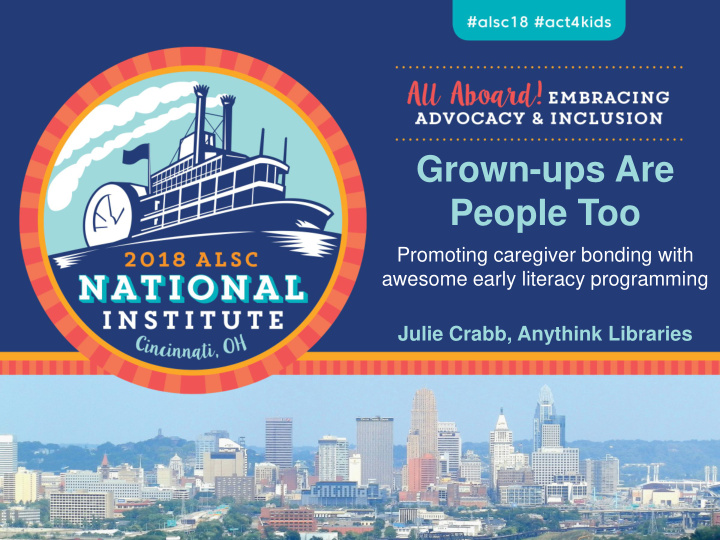



Grown-ups Are People Too Promoting caregiver bonding with awesome early literacy programming Julie Crabb, Anythink Libraries
Who am I? Julie Crabb Lilah Sue Crabb
Why are we here?
Why are we here?
Caregiver Bonding
Caregiver Bonding • Brain development (including emotional, social and cognitive development) depends LARGELY on a loving relationship with a primary grown-up.
Caregiver Bonding Neglect and lack of attachment can lead to: -Increased depression risk due to a lack of growth in the left hemisphere. -Anxiety disorders due to sensitivity in the limbic system. -Learning disabilities and memory impairments due to minimal growth of the hippocampus. Rutter M. Resilience in the face of adversity. Protective factors and resistance to psychiatric disorder. The British Journal of Psychiatry. 1985;147:598 – 611. Teicher MD. Wounds that time won’t heal: the neurobiology of child abuse. Cerebrum: The Dana Forum on brain science. 2000;2:50 – 67.
Caregiver Bonding Lab mice put in the care of a loving adult (whether it was related or not) grew up to be a more loving parent to their own pups. Methylation changes – chemical patterns passing over generations Champagne FA, Francis DD, Mar A, Meaney MJ. Variations in maternal care in the rat as a mediating influence for the effects of environment on development. Physiol. Behav. 2003;79:359 – 371. doi: 10.1016/S0031-9384(03)00149-5.
Caregiver Bonding • Children pick up what we throw down. • If positive experiences do not happen, the grown-up isn’t coming back. • If positive experiences do not happen, the neural pathways for the child may be lost.
Caregiver Bonding
Can I be cool?
What I Did and Do • Step One: Slight adjustments to what I already do.
Pop Songs in Storytime I said a hip hop Hippie to the hippie To the hip, hip a hop, And you don't stop, A rock it To the bang bang boogie, Say up jump the boogie To the rhythm of The boogie, the beat
Popular Culture Storytime
Time for a Challenge
What I Did and Do • Step One: Slight adjustments to what I already do. • Step Two: Research: What do grown-ups like to do?
Research
Mocktails & Masterpieces
What I Did and Do • Step One: Slight adjustments to what I already do. • Step Two: Research: What do grown-ups like to do? • Step Three: Bring the cool stuff to the library.
Cool Things That Cost Me $ • Touched a Truck • Petted Instruments • Learned American Sign Language • Listened to Jazz Guitar • Watched a Polynesian Dance Performance • Had a Real Life Scientist Explain the Senses • Attempted Clay Sculptures • Created Abstract Art • Glued Collages • Drum Circle • Yoga Posed on the Patio
Cool Things That Cost Me No $ • Storytime Special • Opera Singer • Ballerina • Marching Band • Quarterback • Firefighter • Police Officers • Veterinarian • Dentist • Construction Worker
What I Did and Do • Step One: Slight adjustments to what I already do. • Step Two: Research: What do grown-ups like to do? • Step Three: Bring the cool stuff to the library. • Step Four: Bring the library to the cool stuff.
What I Did and Do • Step One: Slight adjustments to what I already do. • Step Two: Research: What do grown-ups like to do? • Step Three: Bring the cool stuff to the library. • Step Four: Bring the library to the cool stuff. • Step Five: Get trendy.
GroovaRoo “ GroovaRoo Babywearing Dance Class - *ICE, ICE BABY* Line Dance.” YouTube, uploaded by GroovaRoo Dance, 16 March 2016, https://youtu.be/VelRPENV2eQ
Babywearing Dance Primer 1. Choose your music. 2. Plan your routines. 3. Know your safety and modifications. 4. Promote! 5. Wear a baby or baby-sized friend. 6. Get your dance on!
Babywearing Dance Primer
Get Trendy
Get Trendy Kid Pins Craft Club • Group voted on next month’s project ahead of time • Library provided supplies • Sometimes we failed, but it was funny • SOO many options • Plug that early literacy!
What I Did and Do • Step One: Slight adjustments to what I already do. • Step Two: Research: What do grown-ups like to do? • Step Three: Bring the cool stuff to the library. • Step Four: Bring the library to the cool stuff. • Step Five: Get trendy. • Step Six: Evaluate, update and repeat.
Stuff Does Not Stay Trendy Long Change it up often Get young friends who know what’s cool Don’t stop, keep trying
What Do I Hope You Took Away? • ALSC Competencies – I. Commitment to Client Group • #6 - Assesses and responds on a regular and systematic basis to the needs and preferences of children, their caregivers, educators, and other adults who use the resources of the children’s department, including those unserved and underserved by the library. • #7 - Cultivates an environment for enjoyable and convenient use of library resources, specifically removing barriers to access presented by socioeconomic circumstances, culture, privilege, language, gender, ability, and other diversities. – III. Programming Skills • #1 - Designs, promotes, presents, and evaluates a variety of programs for children, with consideration of developmental stages and the needs, interests, and goals of all children, their caregivers, and educators in the community. • #4 - Integrates literacy-development techniques in program design and delivery, engaging and empowering caregivers in a culturally competent way. • #6 - Establishes programs and services for parents, individuals and agencies providing childcare, educators, and other professionals in the community who work with children. • #7 - Delivers programs outside or inside the library to meet users where they are, addressing community and educational needs, including those of unserved and underserved populations.
What Do I Hope You Took Away?
Contact Me juliethecrabb@gmail.com @StorytimeCrabb talesforthetiny.com storytimeunderground.com
Recommend
More recommend